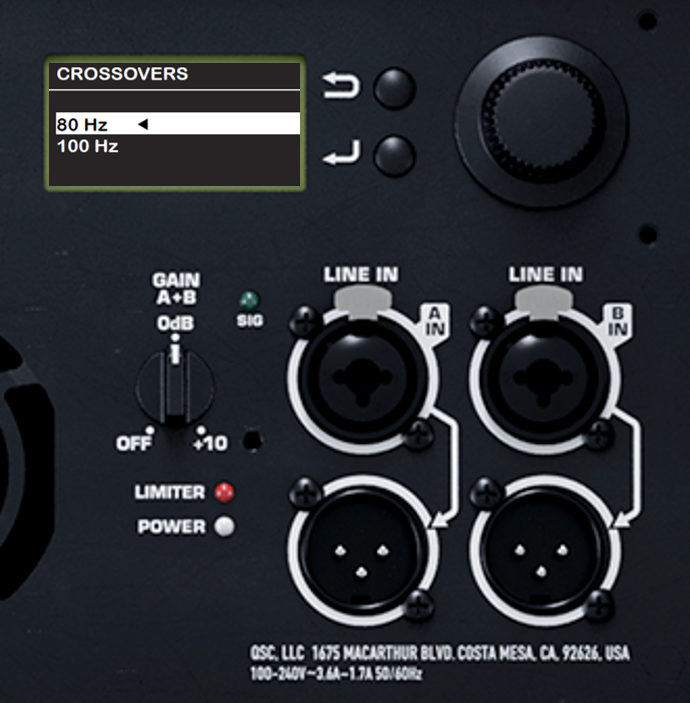Los tres subwoofers activos de la Serie KS incorporan un potente DSP, que permite ajustar varios parámetros de utilidad. Entre ellos se encuentra la frecuencia de corte (filtro de paso bajo). Para que el subwoofer KS se coordine perfectamente con las cajas superiores, será necesario establecer una frecuencia de corte adecuada (80 o 100 Hz) y elegir la configuración correcta tanto en el subwoofer como en las cajas superiores. ¿Qué ocurre si no lo hacemos? Vamos a comprobarlo:
- Subwoofer a 80 Hz y cajas superiores a 80 Hz: esto establece una buena suma de ambas respuestas de frecuencia, con graves potente. Además, el corte de frecuencia en graves a 80 Hz reduce los indicios de la ubicación de los graves.
- Subwoofer a 100 Hz y cajas superiores a 100 Hz: una suma con divisor de frecuencias uniforme, que aporta techo dinámico adicional a los altavoces superiores, lo que produce un ancho de banda de sonido más estrecho.
- Subwoofer a 100 Hz y cajas superiores a 80 Hz: ambos elementos reproducen la misma energía en el intervalo de 80 Hz a 100 Hz, generando un nivel de graves extra.
- Subwoofer a 80 Hz y cajas superiores a 100 Hz: la frecuencia de corte no mostrará una respuesta de frecuencia plana ni uniforme. Habrá una caída de -5 dB centrada aproximadamente en los 90 Hz, lo que se traducirá en una pérdida en la reproducción de graves.
Por ello, el ajuste apropiado del divisor de frecuencias es importante para sacar el mejor partido al subwoofer y los altavoces de QSC.

The following two tabs change content below.


Christophe Anet
Christophe Anet is an electroacoustics engineer and live sound professional. Over the years, his passion for acoustics led him to design recording studios, lecture about psycho-acoustics and calibrate recording studio control rooms around the world. When not playing guitar, you can find him either rock climbing in the Swiss Alps or painting landscape watercolors in the wilderness.
Latest posts by Christophe Anet (see all)
- History, Development and Applications of Column Loudspeakers - May 30, 2025
- Why is Dynamic Range so important? - May 30, 2023
- Differences between Flown and Floor-Mounted Subwoofer Deployments - May 2, 2023

I wanted to thank you for this wonderful read!! I definitely loved every bit of it.
I’ve got you bookmarked to look at new things you post…
How bout speakers at 125 hz / subs at 80
Thanks for your message. A top loudspeaker high-pass set at 125 Hz and a subwoofer low-pass set at 80 Hz will induce a loss in low frequency reproduction level between these two frequuencies, as discussed in the article. The wider the frequencies are set apart, the more LF loss you will perceive. Hope this clarifies your question. Thanks for reading! Best regards.
My question concerns the Presets on the K.2 mid-high boxes (K10.2s in particular.) I like the “Studio Monitor” preset best, I use it for live shows. But obviously some low end has been filtered out. How do I know where to set the crossover on my subs? WHAT IS THE EXACT ROLLOFF THAT’S BEING USED ON EACH PRESET? WHY DOESN’T QSC SHARE THIS INFO? WHO CARES IF IT’S “PRIORITY INTELLECTUAL PROPERTY” – WE PAID FOR THE BOXES, WE NEED TO KNOW!
Hello and thanks for your note. The Studio Monitor preset on QSC K.2 Series has been designed to provide a very flat frequency response across the full bandwith of the loudspeaker. There is actually no LF that is filtered-out, but a rather flat bass response that is implemented. K2 Series feature 11 different presets, and each one has different set of contour equalization, which means that there are differences in response magnitude (levels), but no changes in the actual loudspeaker LF roll-off. The lowest possible high-pass setting is 80 Hz (applicable with all presets), with 100 and 125 Hz also available. So, the question is to find out what low-pass setting is available with your subwoofer and find a matching crossover frequency in the 3 choices provided on K.2 Series. The bottom line is that you can mix and match any preset with any crossover setting, without any loss of low frequencies. Hope this is helpful, and thanks for reading. Best regards.
I just bought a DBX Drive Rack PA2. I am trying to set up the cross over with my k8.2 and ks112. Do you know the settings for setting up an external crossover. Any help would be great.
Hello Rudolf, and thanks for your question. Whatever model of external crossover you use, the most important principle to follow is to set both low-pass and high-pass at the same frequency with the same roll-off slope (24 dB/octave, etc). You can select 80 or 85 Hz for K8.2 and KS112, and the system will work very well. Hope this is useful. Best regards.